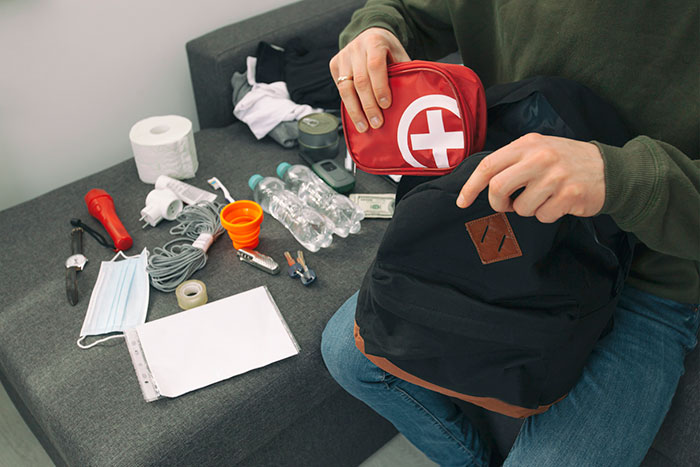Every home, business, and vehicle should be equipped with a well-stocked first aid kit – It allows you to quickly address minor injuries and illnesses, potentially preventing them from escalating. From compact kits with the basic essentials to large comprehensive first aid boxes, there’s so many options available, determining which kit best suits your needs can be a challenge. Here’s a few top considerations to keep in mind when selecting the ideal first aid kit for your home, office, or on-the-go.
First and foremost, assess your specific needs.
Are you looking to equip your home, your car, or a remote location? The contents of your first aid kit should be tailored to the potential risks and hazards you may encounter in those environments. For example, a kit for a household with young children may prioritise items for treating minor cuts, scrapes, and burns, while a kit for outdoor activities may focus more on supplies for sprains, insect bites, and other wilderness-related injuries. And for travel, it’s important to have versatile supplies that can tackle a variety of scenarios, from motion sickness to sunburn.
Next, consider the size and portability of the first aid kit.
If you need to keep it in a compact space or take it with you on the go, choose a kit that is lightweight and easy to transport. If you have ample storage space, you may want to choose a larger kit with a wider range of supplies.
When reviewing the contents of a first aid kit, make sure it includes the necessary essentials like bandages, band aids, gauze, antiseptic wipes, pain relievers – these items allow you to clean and dress wounds, immobilise injuries, and provide relief until professional medical attention can be obtained. It should also have tools and accessories like scissors, tweezers, thermometers, and emergency blankets, as these can be invaluable in a variety of situations.
By taking the time to choose the right first aid kit for your needs, you can have peace of mind knowing that you are prepared to respond quickly and effectively in the event of an emergency.
Different Types of First Aid Kits
While the basic components of most first aid kits may be similar, there are different types of kits designed for specific settings and needs. Understanding the differences between home, travel, and specialty first aid kits can help ensure you have the right supplies on hand when they’re needed most.
Home First Aid Kits
A home first aid kit is one of the most comprehensive, containing a wide range of supplies to address common injuries and illnesses that may occur within the household. These kits typically include bandages, antiseptics, pain relievers, thermometers, and other essential items for treating minor cuts, burns, sprains, and other non-life-threatening medical situations.
Travel First Aid Kits
Travel first aid kits are more compact and portable, designed to be taken on the go. They contain a streamlined selection of supplies suitable for addressing injuries or health issues that may arise during activities outside the home, such as hiking, camping, or road trips.
Specialty First Aid Kits
Specialty first aid kits are tailored to specific needs or environments. Examples include workplace kits for office settings, sports kits for athletic activities, and marine kits for boating or water-based adventures. These kits may include unique items like eyewash solutions, cold packs, splints, a portable AED defibrillator or other specialised equipment.
Maintaining and Restocking – Your First Aid Kit Should Always Be Ready
It’s not enough to just have a first aid kit in your possession, you need to make sure it’s always ready to go, so take the time to maintain and restock your supplies when needed. Just as you would keep your car’s fuel tank full or your phone charged, your first aid kit deserves that same level of attentiveness.
Check expiration dates – Go through your first aid kit every few months and check the expiration dates on medications, bandages, and other supplies and replace any expired items.
Restock used items – Each time you use something from your first aid kit, make sure to replace it so your kit is always fully stocked and ready.
Add new items as needed – As your family’s needs change over time, update your first aid kit with new items like medications, thermometers, or supplies for young children.
Store properly – Keep your first aid kit in a cool, dry place out of direct sunlight as extreme temperatures can damage the contents.
Make it portable – Choose a container that is easy to grab and go, whether that’s a plastic storage box or a soft-sided bag.
Investing in the right first aid kit gives you confidence that you are equipped to handle minor medical situations. This is especially important when traveling, engaging in outdoor activities, or caring for young children.
Safety Dave stocks a great range of first aid kits to suit all needs and budgets. We are passionate about keeping Australians safe, so get in touch with us today to discuss your safety needs. We can also help with TPMS, reversing cameras, and fire safety equipment – we are proud to be your one-stop safety destination! Browse our first aid kits or defibrillator for sale online now or call 1800 498 657 today.


